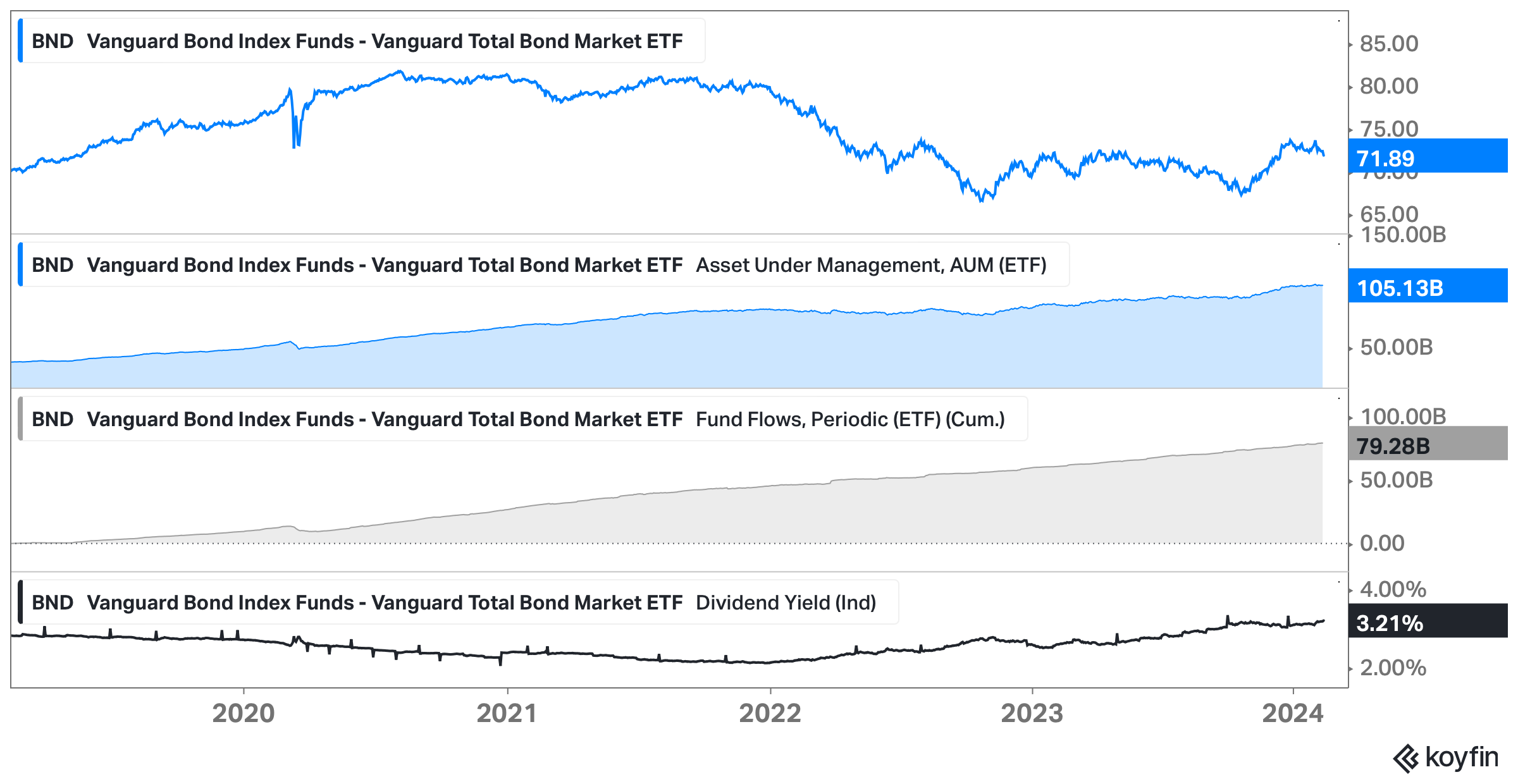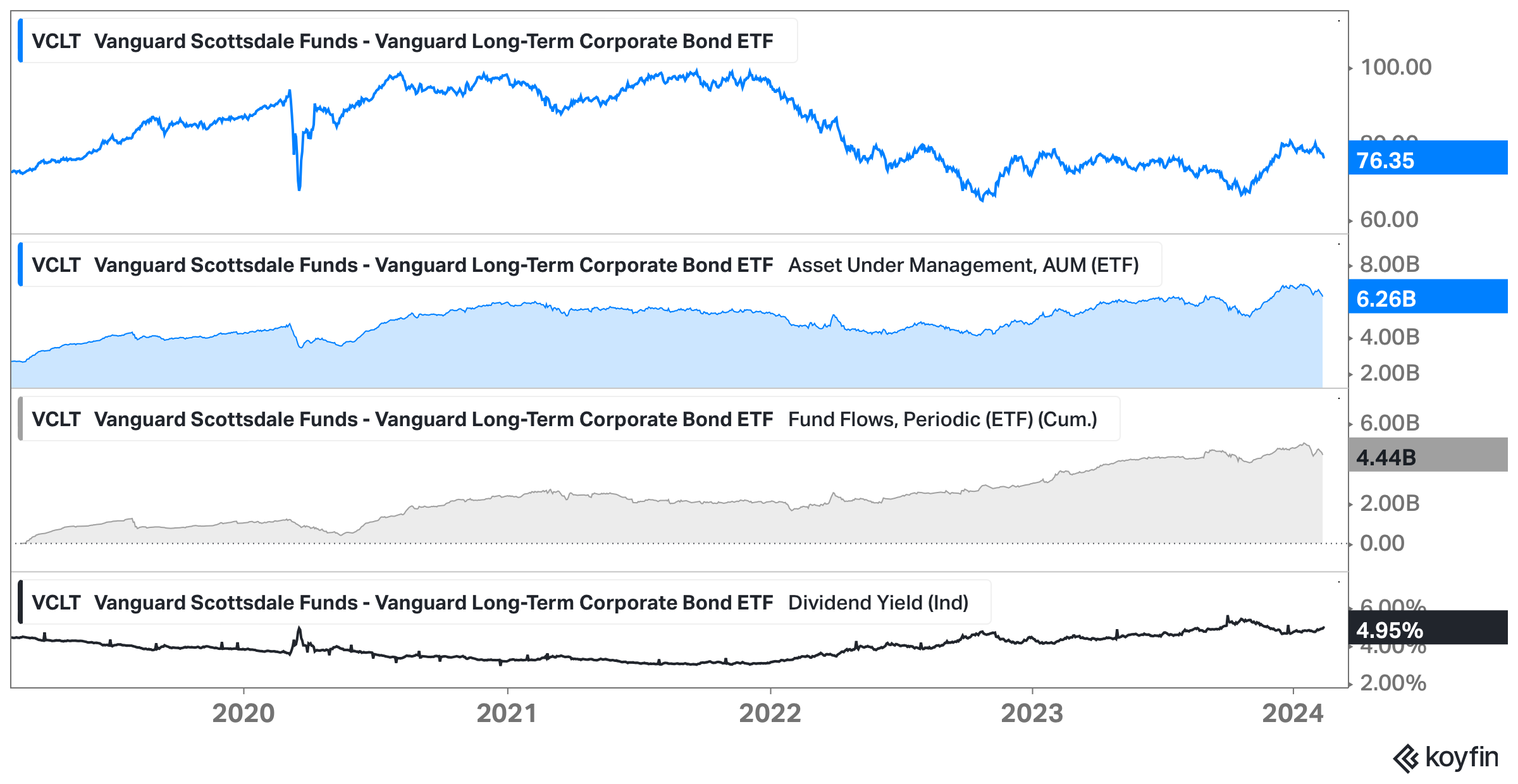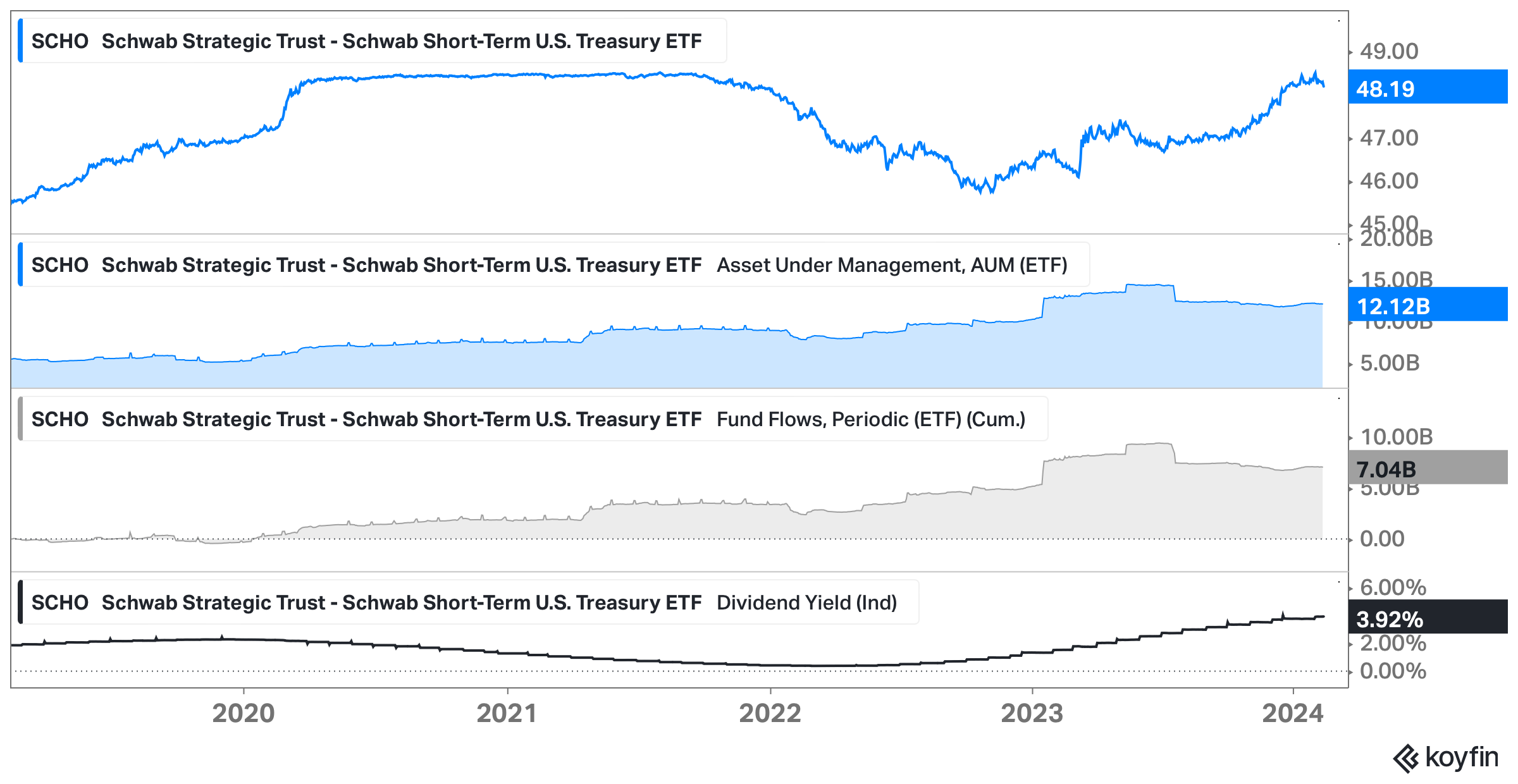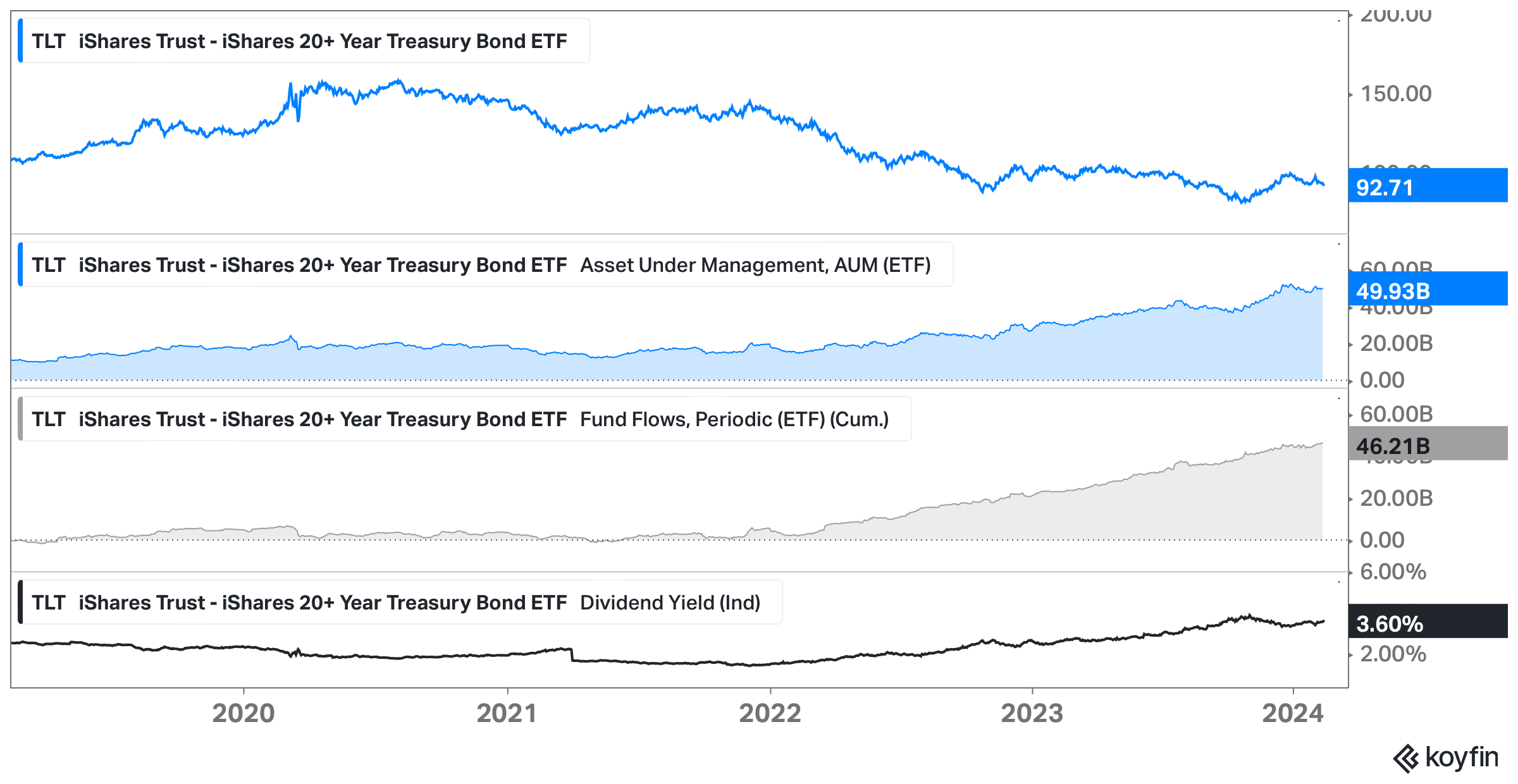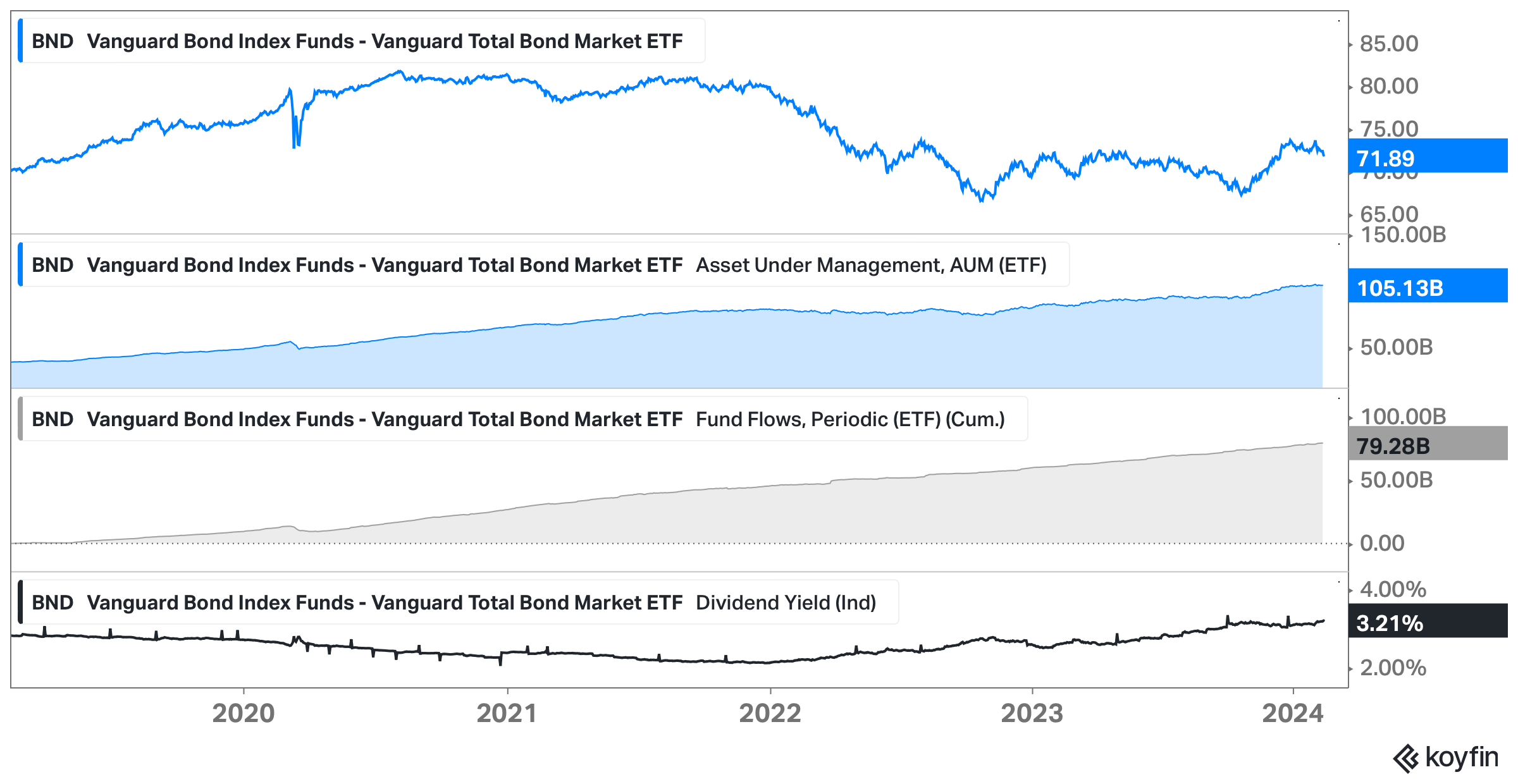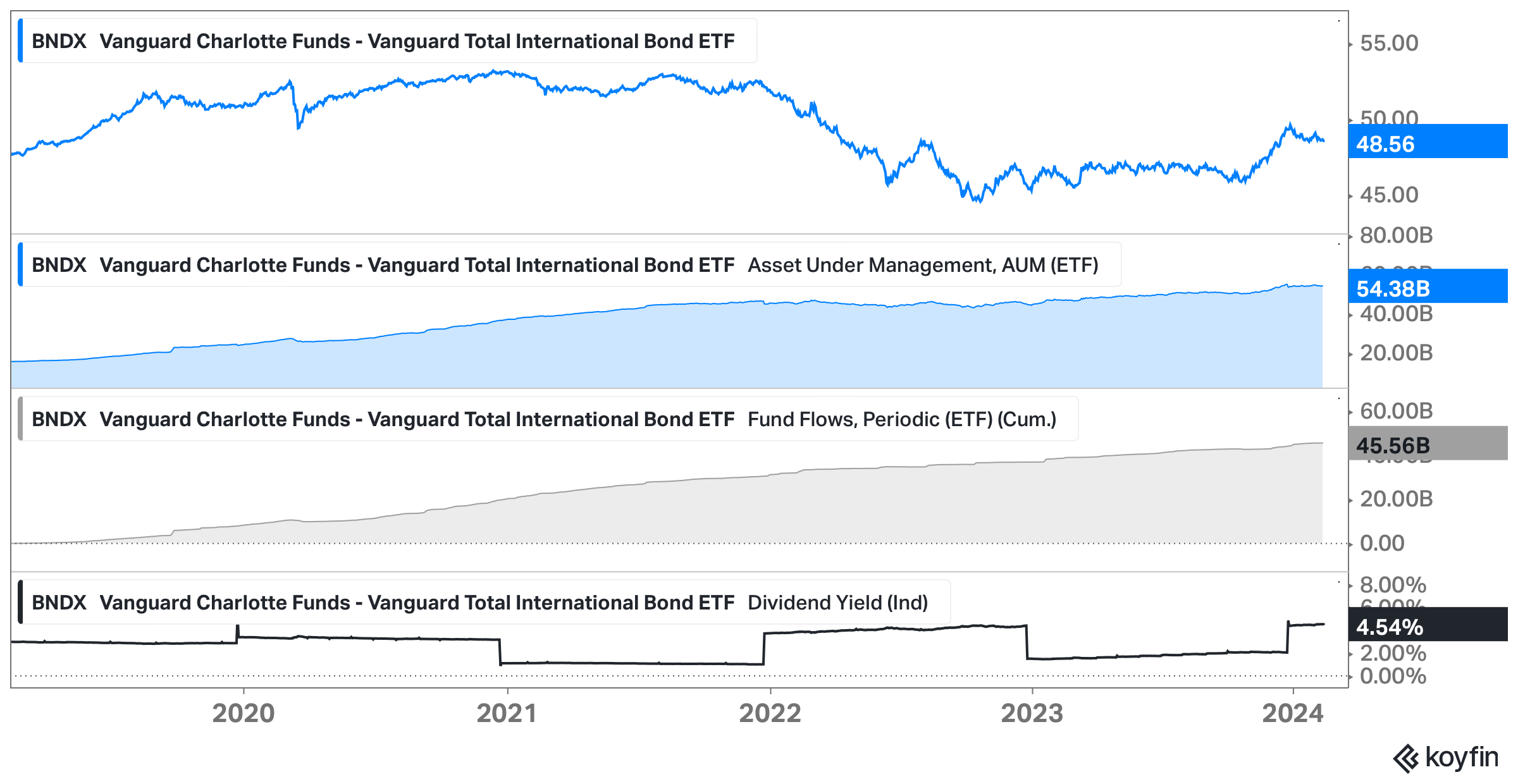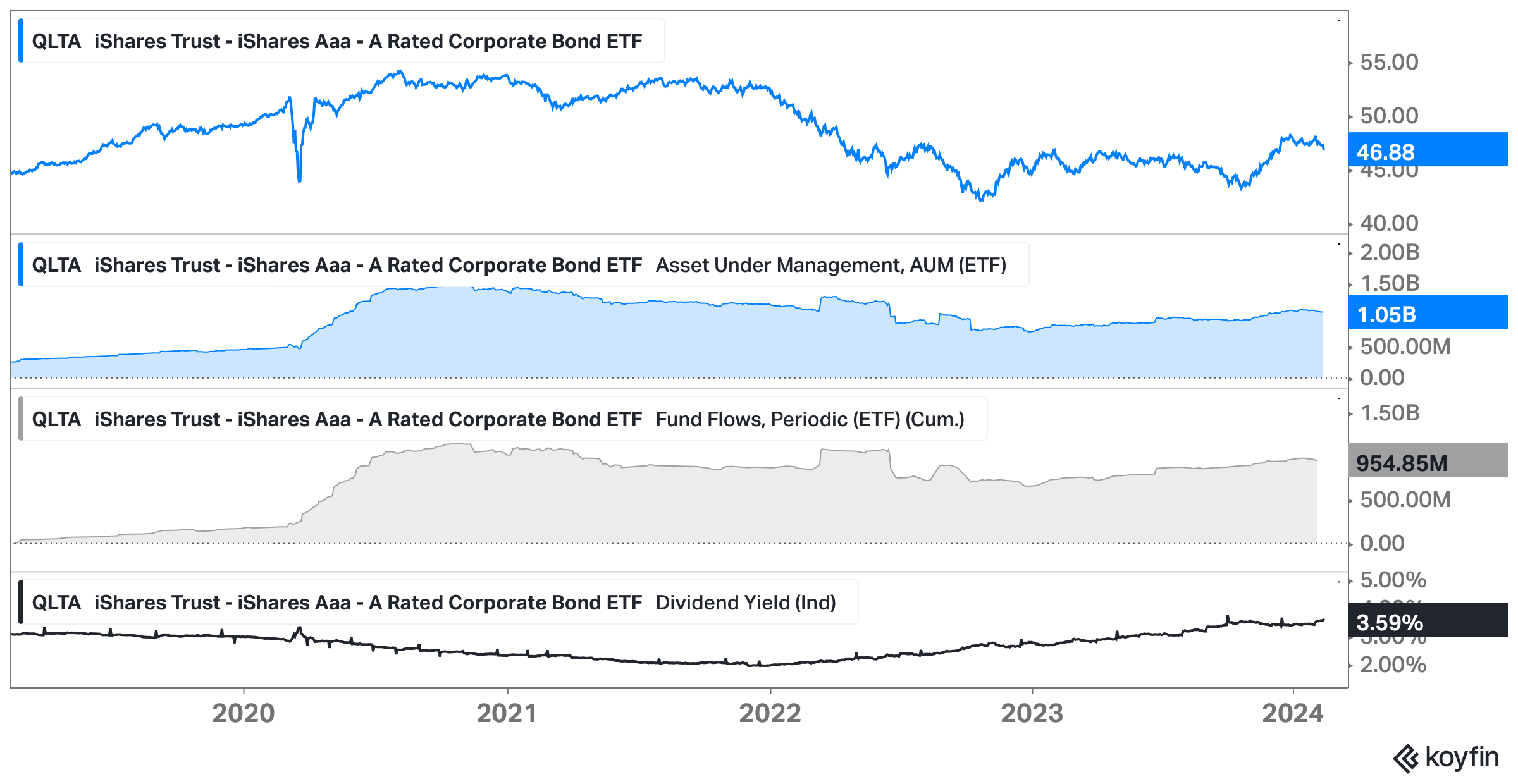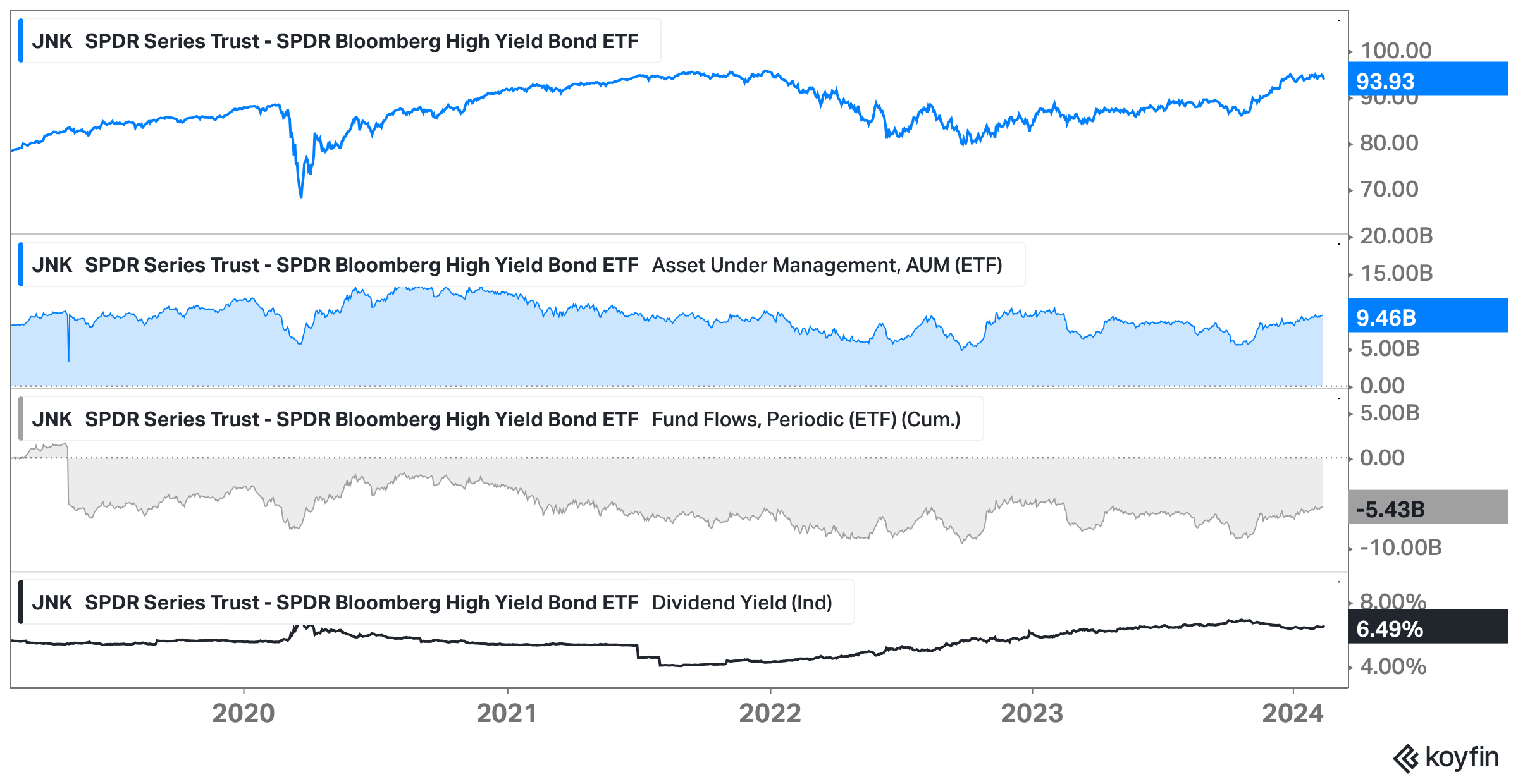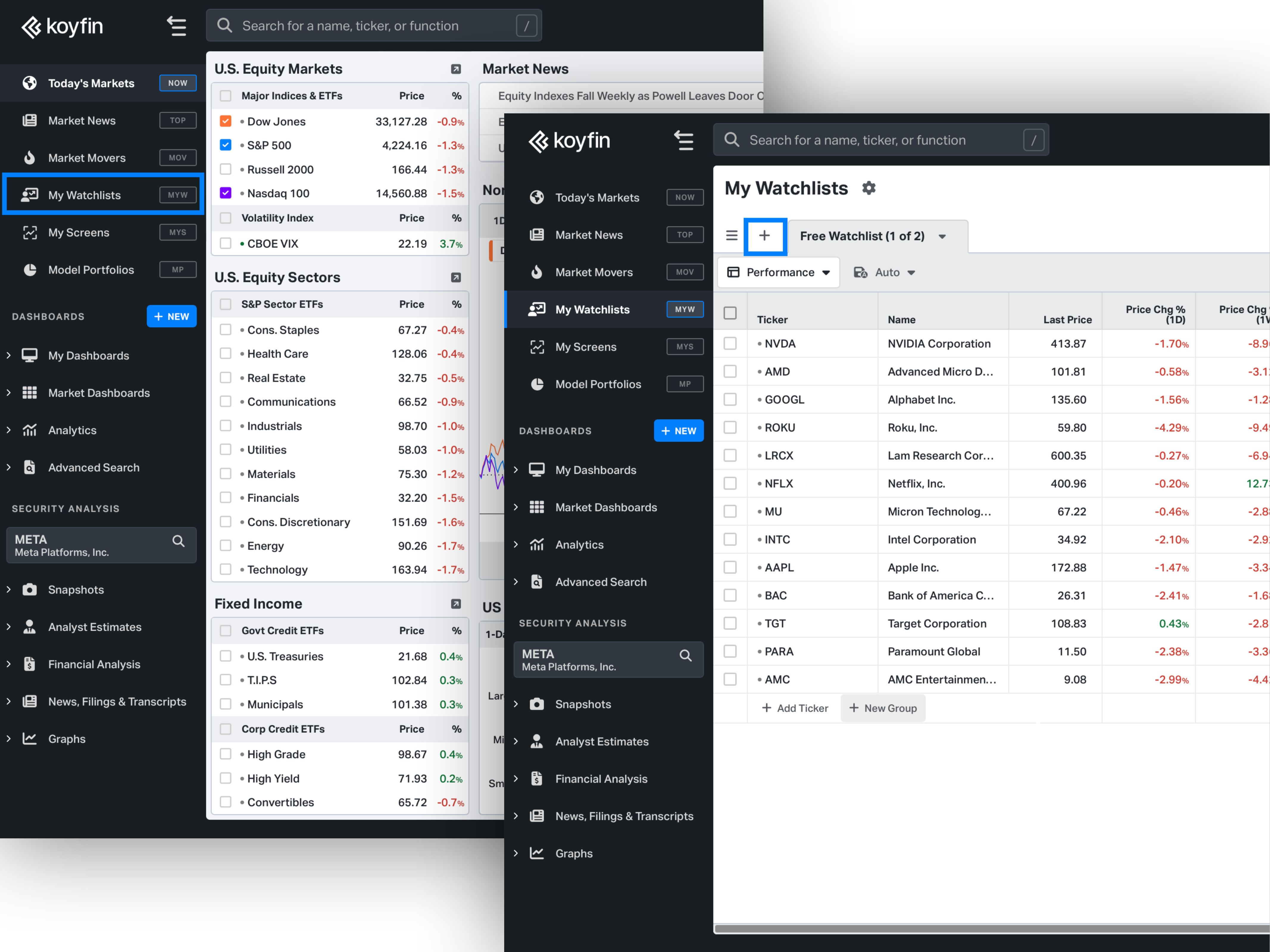8 Best Bond ETFs of 2025: Navigating the Fixed-Income Wave
Bonds are a steadier investment compared to stocks, making them a good choice for those looking for stable income without big market swings. They are especially suited for investors who prefer safety over high returns. The main thing to watch with bonds is interest rates: if these rates go up beyond the bond’s interest rate, the bond becomes less attractive, and its value drops. There’s a wide variety of bonds, differing in who issues them, where they’re from, their credit quality, costs, how long they last, and their interest rates. For an easy way to invest in bonds across the world without much hassle, Bond ETFs are a practical option, offering affordability and easy access.
PRO TIP:
When exploring bond ETFs, consider a range of criteria to ensure a well-rounded investment:
- Solid credit ratings: With one exception, the funds in these lists are comprised of those which are heavily concentrated in investment-grade fixed income securities. Credit ratings indicate the likelihood of the bond getting repaid by the issuer (government, agency, or corporation). It’s important to note that an ETF has a credit rating, but the individual securities within the ETF have different credit ratings.
- Low cost: Seven of the eight funds in this list have expense ratios below 0.15%, and one has an expense ratio of 0.40%. Cost is especially important with bond ETFs due to bonds’ typical lower expected returns when compared to equities.
- Attractive yield: Because the expected returns on bonds are lower, we have curated a selection of funds that offer attractive yields.
- Non-levered: None of the funds in this list is levered.
- Diversity in composition: The funds chosen offer an array of specialization across government securities, corporate bonds, domestic and international exposure, average maturity, and credit quality
Streamline Your ETFs Search
The Koyfin Screener allows scanning through more than 100K global securities using 5,900+ filter criteria. Set filters as mentioned in our Pro Tip to refine your search.
For those interested in other screening tools, the ‘Best Stock Screeners’ blog post offers a comparison to help find the perfect match.
The 8 Best Bond ETFs of February 2025
Name | Ticker | AUM | Dividend Yield (Ind) |
|---|---|---|---|
Vanguard Total Bond Market ETF | BND | $105.1 billion | 3.20% |
iShares Core U.S. Aggregate Bond ETF | AGG | $100.9 billion | 3.20% |
Vanguard Total International Bond ETF | BNDX | $54.3 billion | 4.54% |
iShares 20+ Year Treasury Bond ETF | TLT | $49.3 billion | 3.60% |
Schwab Short-Term US Treasury ETF | SCHO | $12.1 billion | 3.92% |
SPDR Bloomberg High Yield Bond ETF | JNK | $9.40 billion | 6.50% |
Vanguard Long-Term Corporate Bond ETF | VCLT | $6.4 billion | 4.94% |
iShares Aaa - A Rated Corporate Bond ETF | QLTA | $1.1 billion | 3.59% |
*Data as of February 13th, 2025
Investing in bond ETFs involves more than initial selection; continuous monitoring is essential. Stay informed about global market trends, as they can significantly impact the performance of these ETFs. Additionally, keep an eye on political and economic developments in the specific regions or countries covered by the ETFs, as these factors can affect their stability and growth potential.
Track ETF Metrics in Koyfin Watchlists
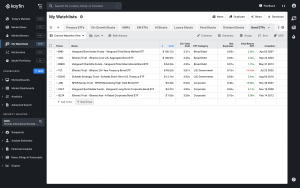
iShares Core U.S. Aggregate Bond ETF (AGG)
AGG is an aggregate bond ETF managed by BlackRock Fund Advisors. It provides broad exposure to investment-grade fixed income securities, investing in fixed-rate treasury bonds, government-related bonds, corporate bonds, mortgage-backed pass-through securities, commercial mortgage-backed securities, and asset-backed securities with a remaining maturity of at least one year. The fund seeks to track the performance of the Bloomberg US Aggregate Bond Index using a representative sampling technique.
Launched in 2003, AGG has a strong track record of AUM growth, now managing $105.1 billion in assets. It offers a yield of 3.21% and has a low net expense ratio of 0.03%, making it suitable for income-focused and cost-conscious investors seeking broad bond exposure. The fund is primarily comprised of securities with AA credit ratings, and 75% of the assets have maturities of less than 10 years.
Credit Rating Exposure:
- AAA: 3.17%
- AA: 71.34%
- A: 11.77%
- BBB: 13.14%
- BB: 0%
- Cash: 0.57%
Maturity Exposure:
- 0-5 Years: 38.4%
- 5-10 Years: 36.9%
- 10-15 Years: 8.8%
- 15 Years to 20 Years: 4.7%
- 20+ Years: 10.6%
Key Investment Insights for iShares Core U.S. Aggregate Bond ETF (AGG):
Yield | 3.21% |
AUM | $105.1 billion |
Category | Broad Debt |
Net Expense Ratio | 0.03% |
5Y Total Return | 2.58% |
Inception | 2003 |
Vanguard Long-Term Corporate Bond ETF (VCLT)
VCLT is a long-term corporate bond ETF managed by Vanguard, focusing on USD-denominated, investment-grade corporate bonds issued by industrial, utility, and financial companies with maturities of over 10 years. The fund aims to track the Bloomberg 10+ Year Corporate Bond Index and currently manages $6.4 billion in AUM.
With a low expense ratio of 0.04%, VCLT offers investors a higher yield of 4.95%, compensating for the increased credit risk associated with its focus on the corporate sector. This fund is suitable for investors willing to trade the relative safety of government bonds for a higher yield. The fund’s average credit ratings are split between A and BBB, with a significant portion of long-maturity bonds; over 64% of the securities have maturities exceeding 20 years.
Credit Rating Exposure:
- AAA: 2.30%
- AA: 9.10%
- A: 42.20%
- BBB: 46.40%
- BB: 0%
- Cash: 0%
Maturity Exposure:
- 0-5 Years: 0%
- 5-10 Years: 0.4%
- 10-15 Years: 14.8%
- 15-20 Years: 19.9%
- 20+ Years: 64.9%
Key Investment Insights for Vanguard Long-Term Corporate Bond ETF (VCLT):
Yield | 4.95% |
AUM | $6.4 billion |
Category | Corporate |
Net Expense Ratio | 0.04% |
5Y Total Return | 5.13% |
Inception | 2009 |
Schwab Short-Term US Treasury ETF (SCHO)
SCHO is a short-term US Treasury ETF managed by Charles Schwab that exclusively invests in US Treasuries with maturities of less than 3 years. The fund solely invests in AAA-rated securities, seeking to track the performance of the Bloomberg US Treasury 1-3 Year Index.
With $12.1 billion in AUM and a low expense ratio of 0.03%, this fund is well-suited for conservative investors looking for cost-effective exposure to the bond market, specifically in high-quality debt with the highest credit rating.
Credit Rating Exposure:
- AAA: 100%
- AA: 0%
- A: 0%
- BBB: 0%
- BB: 0%
- Cash: 0%
Maturity Exposure:
- 0-5 Years: 100%
- 5-10 Years: 0%
- 10-15 Years: 0%
- 15-20 Years: 0%
- 20+ Years: 0%
Key Investment Insights for Schwab Short-Term US Treasury ETF (SCHO):
Yield | 3.92% |
AUM | $12.1 billion |
Category | US Government |
Net Expense Ratio | 0.03% |
5Y Total Return | 5.94% |
Inception | 2010 |
iShares 20+ Year Treasury Bond ETF (TLT)
TLT is the largest US Treasury Bond ETF, managed by BlackRock Fund Advisors, with $49.9 billion in AUM. Like SCHO, it invests exclusively in US Treasuries but focuses on longer-term bonds; 94% of the assets have maturities longer than 20 years. The fund seeks to track the ICE US Treasury 20+ Year Bond Index.
TLT offers a higher yield than SCHO at 3.61%, but comes with a higher expense ratio of 0.15%. The fund’s average credit rating is AA.
Credit Rating Exposure:
- AAA: 0%
- AA: 98.4%
- A: 0%
- BBB: 0%
- BB: 0%
- Cash: 1.6%
Maturity Exposure:
- 0-5 Years: 1.6%
- 5-10 Years: 0%
- 10-15 Years: 0%
- 15-20 Years: 5.7%
- 20+ Years: 93.8%
Key Investment Insights for iShares 20+ Year Treasury Bond ETF (TLT):
Yield | 3.61% |
AUM | $49.9 billion |
Category | US Government |
Net Expense Ratio | 0.15% |
5Y Total Return | -14.39% |
Inception | 2002 |
Vanguard Total Bond Market ETF (BND)
BND is Vanguard’s Total Bond Market ETF, focused on investing in a wide array of fixed-income instruments with medium-term maturities. More than 70% of the securities have maturities between 1 and 10 years. The fund seeks to replicate the performance of the Bloomberg US Aggregate Float-Adjusted Index, investing in US Treasuries, investment-grade corporate bonds, international USD-denominated bonds, and mortgage-backed and asset-backed securities with maturities of more than 1 year.
The fund is similar to AGG, with an identical expense ratio of 0.03% but with a slightly higher yield of 3.21%. However, BND is around one-tenth the size of AGG in terms of AUM.
Credit Rating Exposure:
- US Government: 66.9%
- AAA: 3.8%
- AA: 2.9%
- A: 12.6%
- BBB: 13.8%
- BB: 0%
- Cash: 0%
Maturity Exposure:
- 0-5 Years: 40.8%
- 5-10 Years: 30.5%
- 10-15 Years: 11.2%
- 15-20 Years: 5.1%
- 20+ Years: 12.4%
Key Investment Insights for Vanguard Total Bond Market ETF (BND):
Yield | 3.21% |
AUM | $105.1 billion |
Category | Broad Debt |
Net Expense Ratio | 0.03% |
5Y Total Return | 2.57% |
Inception | 2007 |
Vanguard Total International Bond ETF (BNDX)
BNDX is Vanguard’s Total International Bond ETF, focused on ex-US bonds, which include investment-grade government bonds, government agency bonds, corporate bonds, and securitized non-US instruments like asset-backed securities. With just a 3.1% exposure to the US, this fund invests in assets across Japan (14.5%), France (11.9%), Germany (10.6%), Italy (7.6%), Canada (6.7%), the United Kingdom (6.7%), and Spain (5.5%), among others.
BNDX has $54.3 billion in AUM and, despite the lower yield of 4.5%, offers investors low-cost exposure (0.07% expense ratio) to international fixed-income markets.
Credit Rating Exposure:
- AAA: 24.3%
- AA: 26.4%
- A: 28.2%
- BBB: 19.1%
- Less than BBB: 2.0%
- Cash: 0%
Maturity Exposure:
- 0-5 Years: 41.8%
- 5-10 Years: 29.9%
- 10-15 Years: 8.7%
- 15-20 Years: 7.6%
- 20+ Years: 12.0%
Key Investment Insights for Vanguard Total International Bond ETF (BNDX):
Yield | 4.5% |
AUM | $54.3 billion |
Category | Broad Debt |
Net Expense Ratio | 0.07% |
5Y Total Return | 1.92% |
Inception | 2013 |
iShares Aaa - A Rated Corporate Bond ETF (QLTA)
QLTA is an ETF managed by BlackRock that specifically invests in the highest quality corporate bonds, rated A or higher. The fund takes a similar approach to VCLT, primarily investing in corporate debt across industrials, utilities, and financials, but focuses on higher-quality debt instruments. The fund seeks to replicate the Bloomberg US Corporate Aaa – A Capped Index and has $1.1 billion in AUM, making it the smallest fund on our list.
Compared to VCLT, QLTA has a smaller yield at 3.6% and a higher expense ratio of 0.15%, which is to be expected considering the composition of each fund’s credit quality. Less creditworthy debt tends to have a higher yield.
Credit Rating Exposure:
- AAA: 2.3%
- AA: 14.3%
- A: 83.3%
- BBB: 0.22%
- BB: 0%
- Cash: 0%
Maturity Exposure:
- 0-5 Years: 43%
- 5-10 Years: 29.1%
- 10-15 Years: 4.4%
- 15-20 Years: 6.4%
- 20+ Years: 21.2%
Key Investment Insights for iShares Aaa – A Rated Corporate Bond ETF (QLTA):
Yield | 3.59% |
AUM | $1.1 billion |
Category | Corporate |
Net Expense Ratio | 0.15% |
5Y Total Return | 5.14% |
Inception | 2012 |
SPDR Bloomberg High Yield Bond ETF (JNK)
The State Street JNK ETF is the wildcard on our list. It has the highest expense ratio at 0.4%, but also offers the highest yield at 6.49%. This high yield is due to the fund’s investments in junk-grade corporate bonds across all sectors, those rated BB or lower. The majority of these debt instruments are set to mature within 10 years. The fund seeks to track the performance of the Bloomberg High Yield Very Liquid Index.
This fund is not for the risk-averse.
Credit Rating Exposure:
- AAA: 0.48%
- AA: 0%
- A: 0%
- BBB: 0.51%
- Lower than BB: 99%
- Cash: 0%
Maturity Exposure:
- 0-5 Years: 48.1%
- 5-10 Years: 51.5%
- 10-15 Years: 0.36%
- 15-20 Years: 0%
- 20+ Years: 0%
Key Investment Insights for SPDR Bloomberg High Yield Bond ETF (JNK):
Yield | 6.49% |
AUM | $9.4 billion |
Category | Corporate |
Net Expense Ratio | 0.4% |
5Y Total Return | 20.03% |
Inception | 2007 |
How To Find Top Bond ETFs
Step 1: Sign Up to Koyfin for Free. Register an account and get started; no credit card required.
Step 2: Create a Screener. Head to ‘My Screens’, create a new ETF screener and give it a name.
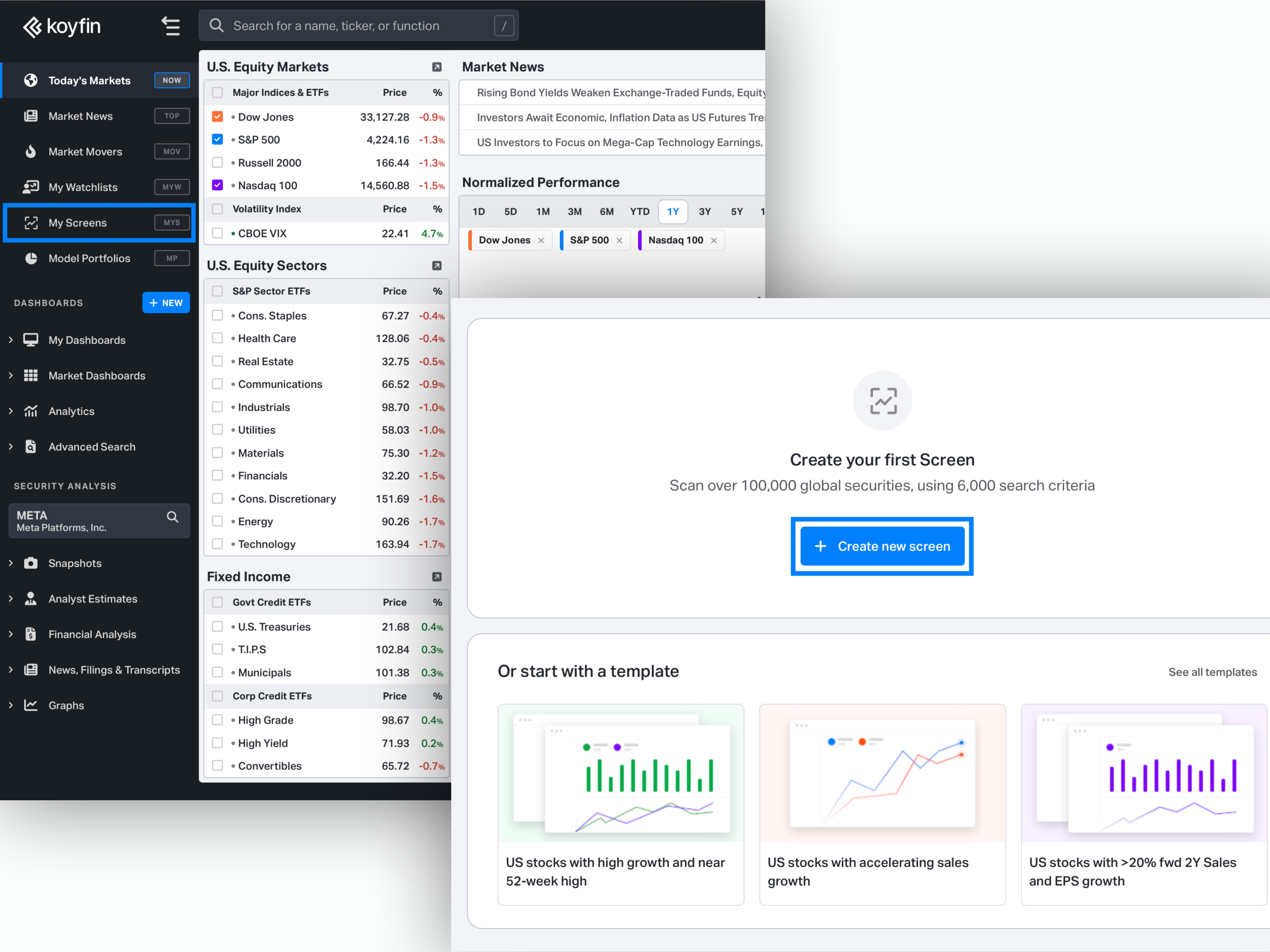
Step 3: Define your Investment Universe. Select a trading region, or multiple regions, and countries.
Choose the asset class for fixed income.

Step 4: Add Filter Criteria. We have thousands of data points you can add to a screener.
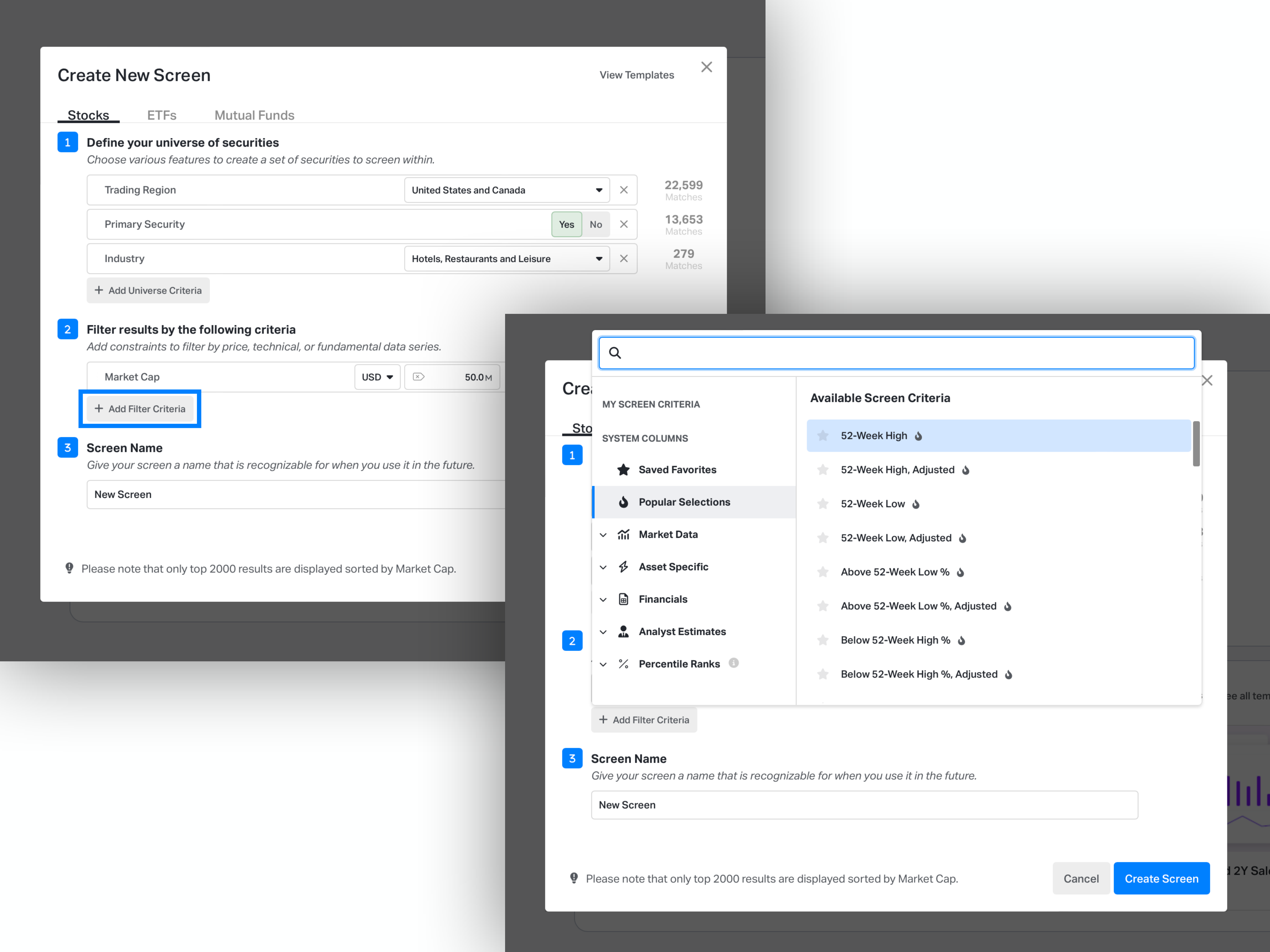
Step 5: Create Screen. When you are happy with your screener, give it a name, hit save and apply. You can also save this screener output as a watchlist too.
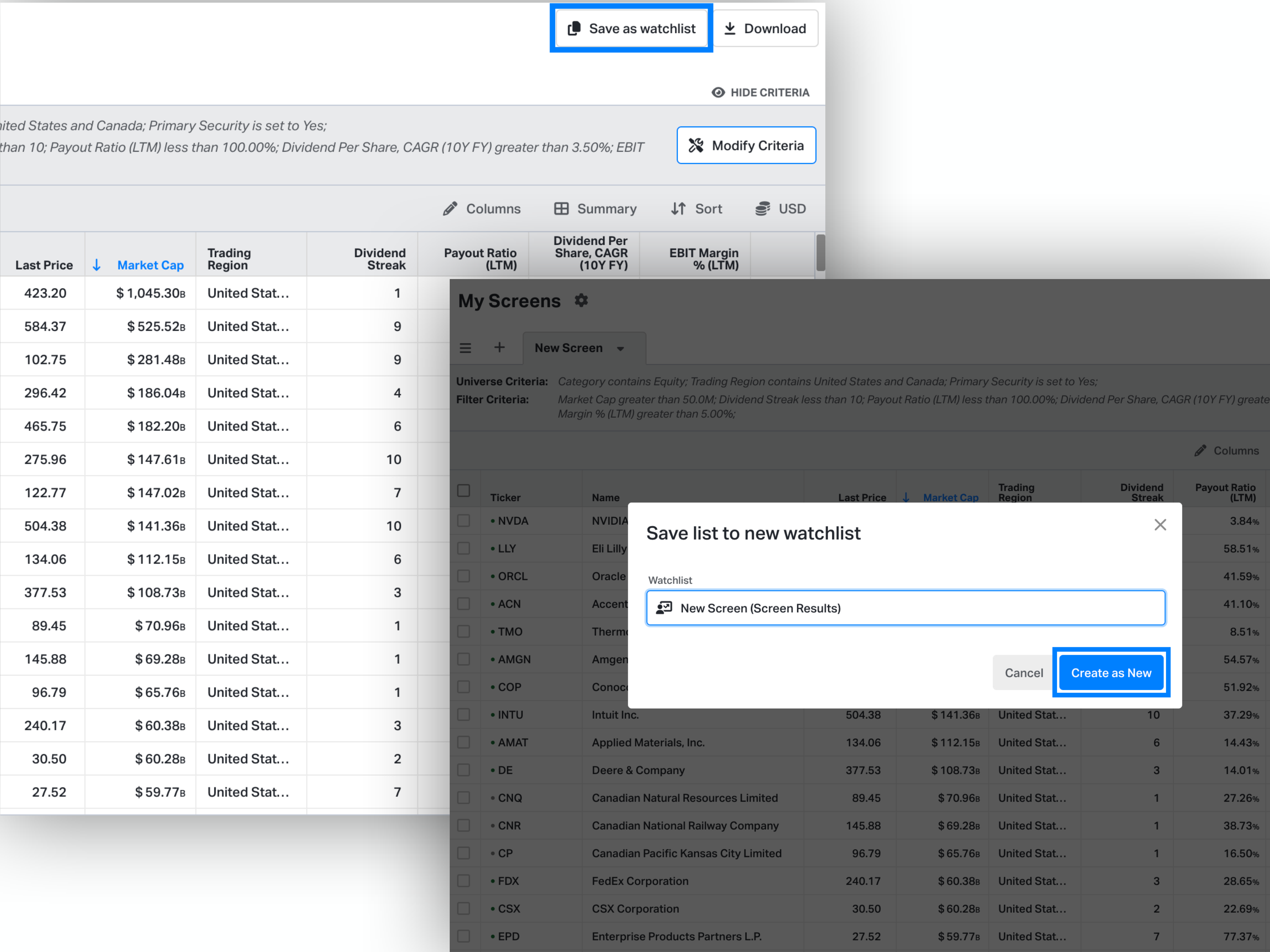
FAQ
-
What is a bond?
A bond is like a loan that an investor gives to a government, city, or company. In return, the borrower (government, city, or company) agrees to pay back the money on a specific date, called the maturity date. While the investor waits for the money to be paid back, they will receive regular interest payments, usually every six months. The interest is often called the “coupon.” Bond funds, which are investment funds that primarily invest in bonds, pool together money from many investors to buy a diversified portfolio of bonds.
-
What are the different types of bonds?
There are many types of bonds, each has its own purpose and offers different risks and returns. Government bonds are loans to the national government and are seen as low risk. Municipal bonds are loans to local governments, used for public projects. Corporate bonds are loans to companies for things like expanding or doing research. There are also agency bonds from government-backed groups, mortgage-backed securities tied to a group of mortgages, and zero-coupon bonds that don’t pay regular interest but are sold at a discount and paid back in full at the end. Bond funds may invest in any combination of these bond types, depending on the fund’s investment objectives and strategies.
-
What is a bond ETF?
A bond ETF is an exchange-traded fund that invests in a portfolio of bonds, usually tracking a specific bond index as a passive investment strategy. Traded on stock exchanges like shares, it provides liquidity and accessibility to investors, while offering the benefits of diversification and avoiding the need to actively manage the bond holdings.
-
How do interest rates affect bonds?
Interest rates and bond prices have an inverse relationship. When interest rates rise, bond prices typically fall, and when interest rates decrease, bond prices generally increase. Here’s why existing bonds pay a fixed interest (coupon rate). If new bonds are issued at higher interest rates (due to a rise in the general interest rate environment), then the older, lower-yielding bonds become less attractive, causing their prices to fall. Conversely, if new bonds are issued at lower interest rates, the older, higher-yielding bonds become more attractive, leading their prices to rise.
-
Do bond ETFs pay dividends?
Yes, Bond ETFs pay dividends to their investors. These dividends are derived from the interest payments collected from the underlying bonds in the ETF’s portfolio. The dividends are typically distributed on a monthly or quarterly basis, depending on the ETF’s structure and the income generated by its holdings. The distribution can be taken in cash or reinvested to buy additional shares of the ETF.
-
What are credit ratings?
Credit ratings are evaluations of a borrower’s ability to repay debt. They’re given by credit rating agencies and range from AAA (best) to D (worst).
- AAA: Highest rating, indicating an extremely low risk of default.
- AA: Very low risk of default.
- A: Low risk of default.
- BBB: Moderate risk of default.
- BB, B, CCC, CC, C: High risk of default, known as “junk” ratings.
- D: Indicates that the borrower has already defaulted on their debt.
Credit ratings signal the risk level of an investment by reflecting the issuer’s financial health, payment record, and debt terms. While not guarantees, they are trusted indicators of credit risk for investors.
-
How can I screen for bond ETFs?
Koyfin offers a screener which can screen ETFs by dividend yield, category, performance, AUM and other metrics.
Editorial note
Our insights are derived solely from historical information and analyst predictions, employing an impartial approach. Please note that our articles do not serve as financial guidance.

